Teaching and Learning of Health Professionals
VerifiedAdded on 2023/06/08
|7
|1528
|491
AI Summary
This article discusses the three domains of educational objectives in health care - cognitive, psychomotor, and affective domains. It provides nursing objectives in each domain and explains how learning objectives can help identify the learning needs of the learners.
Contribute Materials
Your contribution can guide someone’s learning journey. Share your
documents today.

Running head: Teaching and Learning of health professionals
Teaching and Learning of health professionals
Name of the Student:
Name of University:
Author Note:
Teaching and Learning of health professionals
Name of the Student:
Name of University:
Author Note:
Secure Best Marks with AI Grader
Need help grading? Try our AI Grader for instant feedback on your assignments.
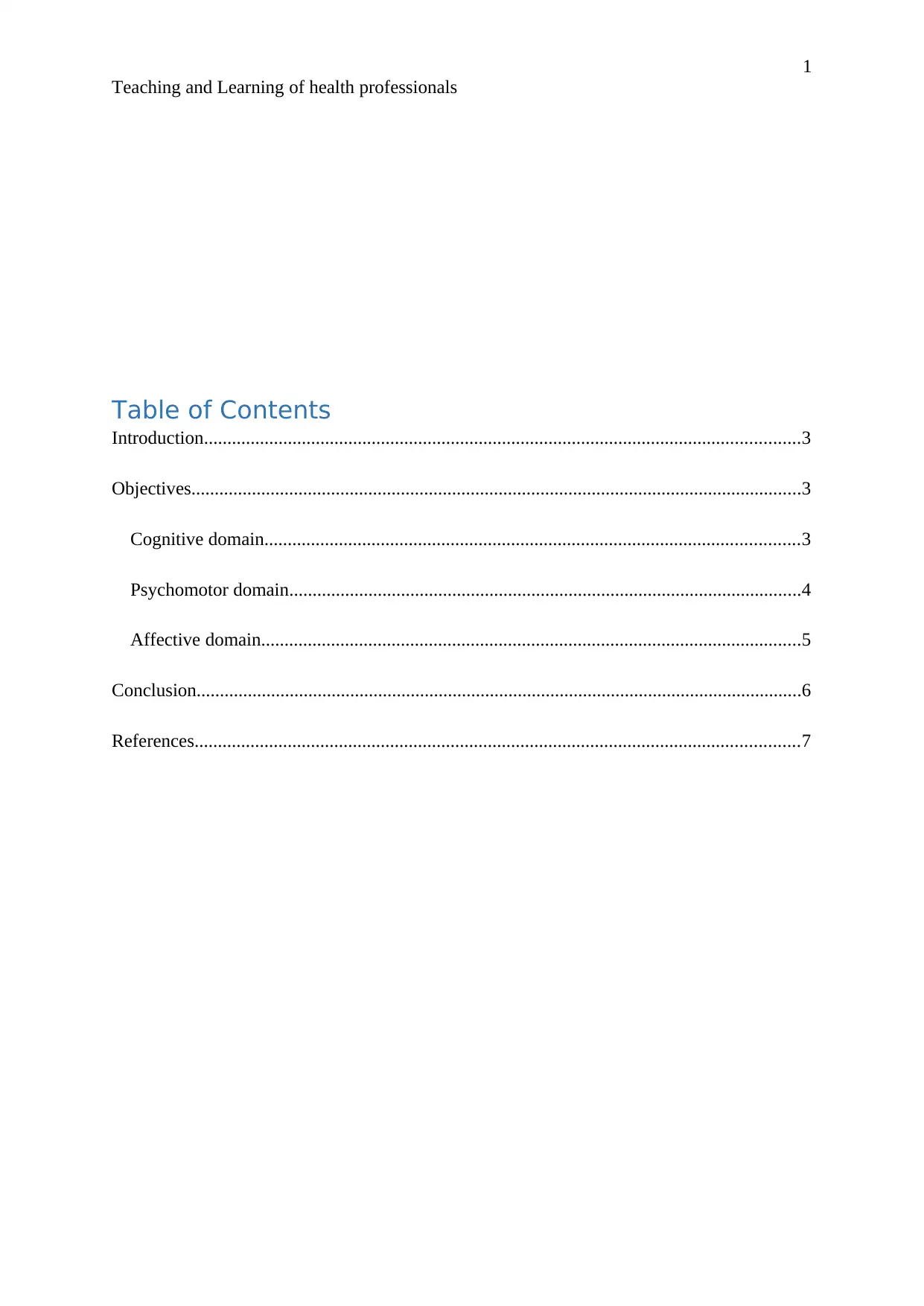
1
Teaching and Learning of health professionals
Table of Contents
Introduction................................................................................................................................3
Objectives...................................................................................................................................3
Cognitive domain...................................................................................................................3
Psychomotor domain..............................................................................................................4
Affective domain....................................................................................................................5
Conclusion..................................................................................................................................6
References..................................................................................................................................7
Teaching and Learning of health professionals
Table of Contents
Introduction................................................................................................................................3
Objectives...................................................................................................................................3
Cognitive domain...................................................................................................................3
Psychomotor domain..............................................................................................................4
Affective domain....................................................................................................................5
Conclusion..................................................................................................................................6
References..................................................................................................................................7
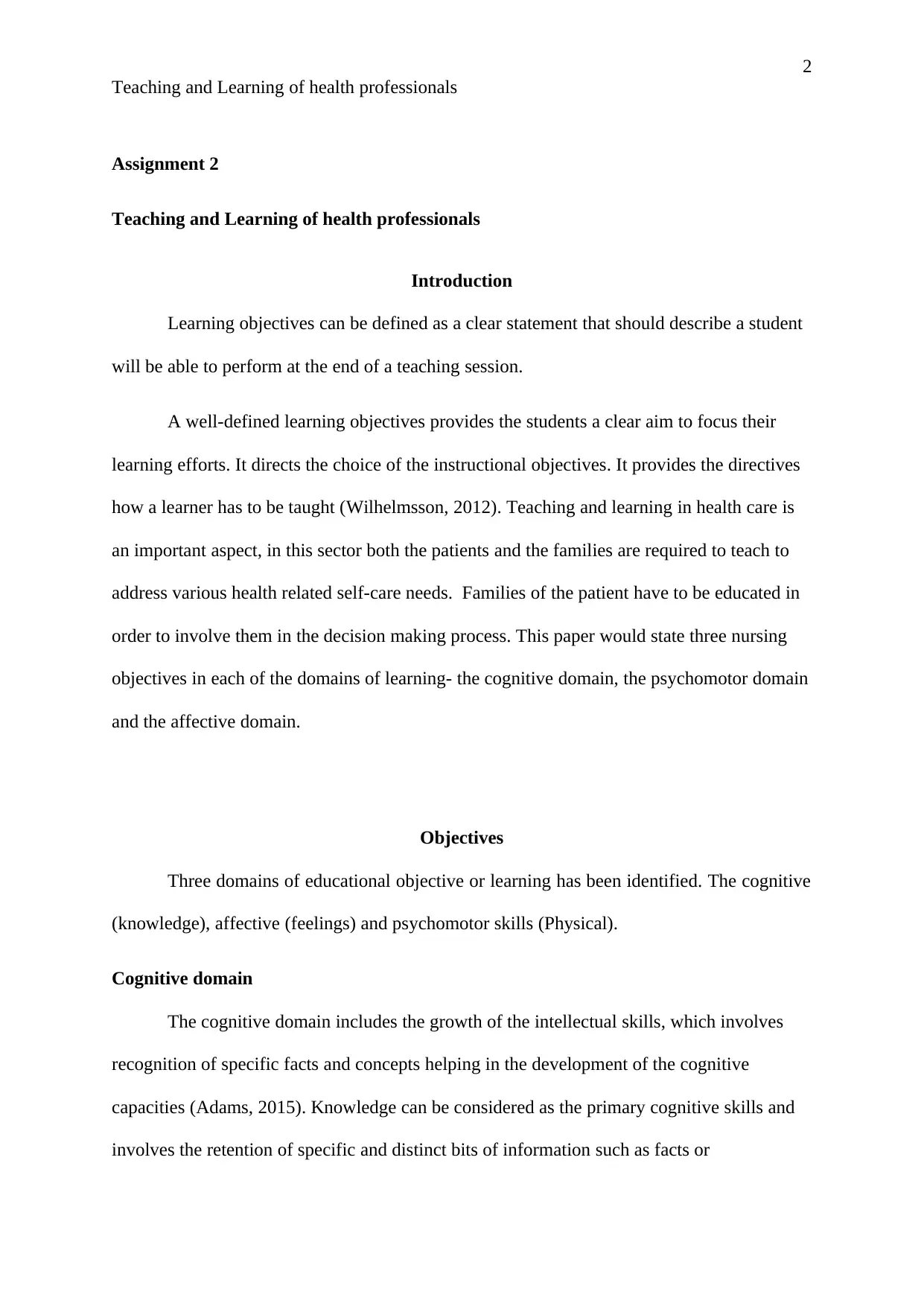
2
Teaching and Learning of health professionals
Assignment 2
Teaching and Learning of health professionals
Introduction
Learning objectives can be defined as a clear statement that should describe a student
will be able to perform at the end of a teaching session.
A well-defined learning objectives provides the students a clear aim to focus their
learning efforts. It directs the choice of the instructional objectives. It provides the directives
how a learner has to be taught (Wilhelmsson, 2012). Teaching and learning in health care is
an important aspect, in this sector both the patients and the families are required to teach to
address various health related self-care needs. Families of the patient have to be educated in
order to involve them in the decision making process. This paper would state three nursing
objectives in each of the domains of learning- the cognitive domain, the psychomotor domain
and the affective domain.
Objectives
Three domains of educational objective or learning has been identified. The cognitive
(knowledge), affective (feelings) and psychomotor skills (Physical).
Cognitive domain
The cognitive domain includes the growth of the intellectual skills, which involves
recognition of specific facts and concepts helping in the development of the cognitive
capacities (Adams, 2015). Knowledge can be considered as the primary cognitive skills and
involves the retention of specific and distinct bits of information such as facts or
Teaching and Learning of health professionals
Assignment 2
Teaching and Learning of health professionals
Introduction
Learning objectives can be defined as a clear statement that should describe a student
will be able to perform at the end of a teaching session.
A well-defined learning objectives provides the students a clear aim to focus their
learning efforts. It directs the choice of the instructional objectives. It provides the directives
how a learner has to be taught (Wilhelmsson, 2012). Teaching and learning in health care is
an important aspect, in this sector both the patients and the families are required to teach to
address various health related self-care needs. Families of the patient have to be educated in
order to involve them in the decision making process. This paper would state three nursing
objectives in each of the domains of learning- the cognitive domain, the psychomotor domain
and the affective domain.
Objectives
Three domains of educational objective or learning has been identified. The cognitive
(knowledge), affective (feelings) and psychomotor skills (Physical).
Cognitive domain
The cognitive domain includes the growth of the intellectual skills, which involves
recognition of specific facts and concepts helping in the development of the cognitive
capacities (Adams, 2015). Knowledge can be considered as the primary cognitive skills and
involves the retention of specific and distinct bits of information such as facts or
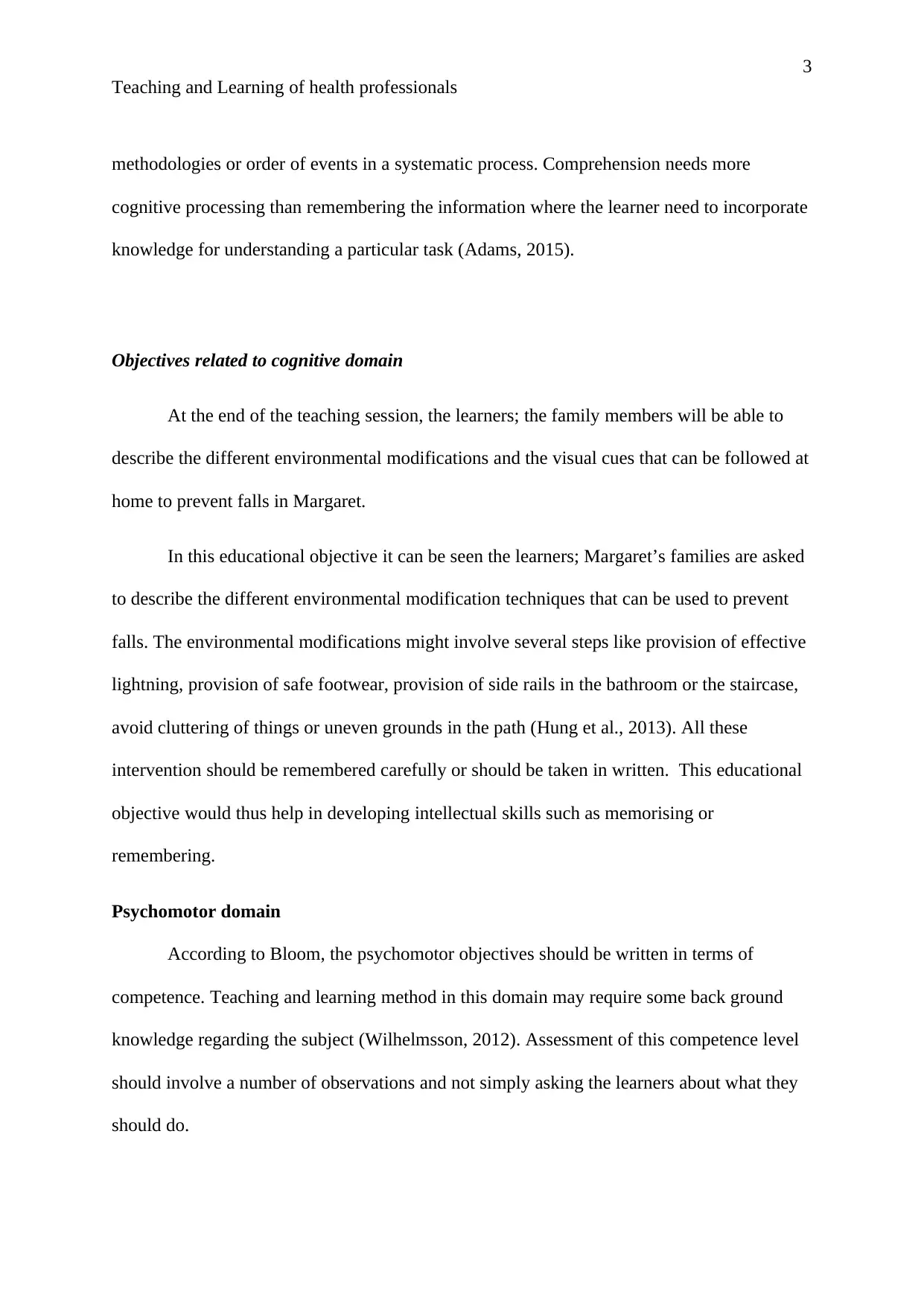
3
Teaching and Learning of health professionals
methodologies or order of events in a systematic process. Comprehension needs more
cognitive processing than remembering the information where the learner need to incorporate
knowledge for understanding a particular task (Adams, 2015).
Objectives related to cognitive domain
At the end of the teaching session, the learners; the family members will be able to
describe the different environmental modifications and the visual cues that can be followed at
home to prevent falls in Margaret.
In this educational objective it can be seen the learners; Margaret’s families are asked
to describe the different environmental modification techniques that can be used to prevent
falls. The environmental modifications might involve several steps like provision of effective
lightning, provision of safe footwear, provision of side rails in the bathroom or the staircase,
avoid cluttering of things or uneven grounds in the path (Hung et al., 2013). All these
intervention should be remembered carefully or should be taken in written. This educational
objective would thus help in developing intellectual skills such as memorising or
remembering.
Psychomotor domain
According to Bloom, the psychomotor objectives should be written in terms of
competence. Teaching and learning method in this domain may require some back ground
knowledge regarding the subject (Wilhelmsson, 2012). Assessment of this competence level
should involve a number of observations and not simply asking the learners about what they
should do.
Teaching and Learning of health professionals
methodologies or order of events in a systematic process. Comprehension needs more
cognitive processing than remembering the information where the learner need to incorporate
knowledge for understanding a particular task (Adams, 2015).
Objectives related to cognitive domain
At the end of the teaching session, the learners; the family members will be able to
describe the different environmental modifications and the visual cues that can be followed at
home to prevent falls in Margaret.
In this educational objective it can be seen the learners; Margaret’s families are asked
to describe the different environmental modification techniques that can be used to prevent
falls. The environmental modifications might involve several steps like provision of effective
lightning, provision of safe footwear, provision of side rails in the bathroom or the staircase,
avoid cluttering of things or uneven grounds in the path (Hung et al., 2013). All these
intervention should be remembered carefully or should be taken in written. This educational
objective would thus help in developing intellectual skills such as memorising or
remembering.
Psychomotor domain
According to Bloom, the psychomotor objectives should be written in terms of
competence. Teaching and learning method in this domain may require some back ground
knowledge regarding the subject (Wilhelmsson, 2012). Assessment of this competence level
should involve a number of observations and not simply asking the learners about what they
should do.
Secure Best Marks with AI Grader
Need help grading? Try our AI Grader for instant feedback on your assignments.
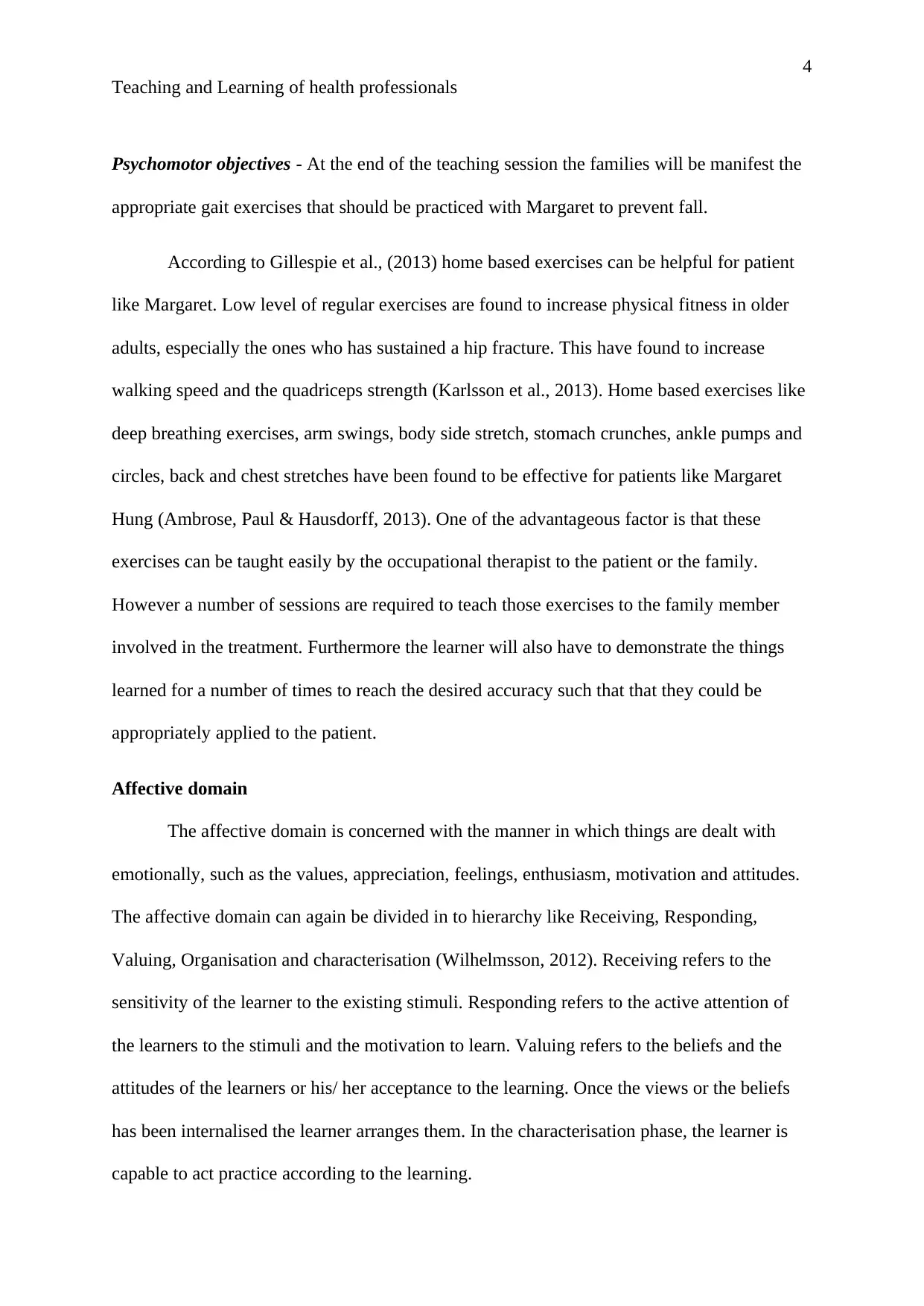
4
Teaching and Learning of health professionals
Psychomotor objectives - At the end of the teaching session the families will be manifest the
appropriate gait exercises that should be practiced with Margaret to prevent fall.
According to Gillespie et al., (2013) home based exercises can be helpful for patient
like Margaret. Low level of regular exercises are found to increase physical fitness in older
adults, especially the ones who has sustained a hip fracture. This have found to increase
walking speed and the quadriceps strength (Karlsson et al., 2013). Home based exercises like
deep breathing exercises, arm swings, body side stretch, stomach crunches, ankle pumps and
circles, back and chest stretches have been found to be effective for patients like Margaret
Hung (Ambrose, Paul & Hausdorff, 2013). One of the advantageous factor is that these
exercises can be taught easily by the occupational therapist to the patient or the family.
However a number of sessions are required to teach those exercises to the family member
involved in the treatment. Furthermore the learner will also have to demonstrate the things
learned for a number of times to reach the desired accuracy such that that they could be
appropriately applied to the patient.
Affective domain
The affective domain is concerned with the manner in which things are dealt with
emotionally, such as the values, appreciation, feelings, enthusiasm, motivation and attitudes.
The affective domain can again be divided in to hierarchy like Receiving, Responding,
Valuing, Organisation and characterisation (Wilhelmsson, 2012). Receiving refers to the
sensitivity of the learner to the existing stimuli. Responding refers to the active attention of
the learners to the stimuli and the motivation to learn. Valuing refers to the beliefs and the
attitudes of the learners or his/ her acceptance to the learning. Once the views or the beliefs
has been internalised the learner arranges them. In the characterisation phase, the learner is
capable to act practice according to the learning.
Teaching and Learning of health professionals
Psychomotor objectives - At the end of the teaching session the families will be manifest the
appropriate gait exercises that should be practiced with Margaret to prevent fall.
According to Gillespie et al., (2013) home based exercises can be helpful for patient
like Margaret. Low level of regular exercises are found to increase physical fitness in older
adults, especially the ones who has sustained a hip fracture. This have found to increase
walking speed and the quadriceps strength (Karlsson et al., 2013). Home based exercises like
deep breathing exercises, arm swings, body side stretch, stomach crunches, ankle pumps and
circles, back and chest stretches have been found to be effective for patients like Margaret
Hung (Ambrose, Paul & Hausdorff, 2013). One of the advantageous factor is that these
exercises can be taught easily by the occupational therapist to the patient or the family.
However a number of sessions are required to teach those exercises to the family member
involved in the treatment. Furthermore the learner will also have to demonstrate the things
learned for a number of times to reach the desired accuracy such that that they could be
appropriately applied to the patient.
Affective domain
The affective domain is concerned with the manner in which things are dealt with
emotionally, such as the values, appreciation, feelings, enthusiasm, motivation and attitudes.
The affective domain can again be divided in to hierarchy like Receiving, Responding,
Valuing, Organisation and characterisation (Wilhelmsson, 2012). Receiving refers to the
sensitivity of the learner to the existing stimuli. Responding refers to the active attention of
the learners to the stimuli and the motivation to learn. Valuing refers to the beliefs and the
attitudes of the learners or his/ her acceptance to the learning. Once the views or the beliefs
has been internalised the learner arranges them. In the characterisation phase, the learner is
capable to act practice according to the learning.
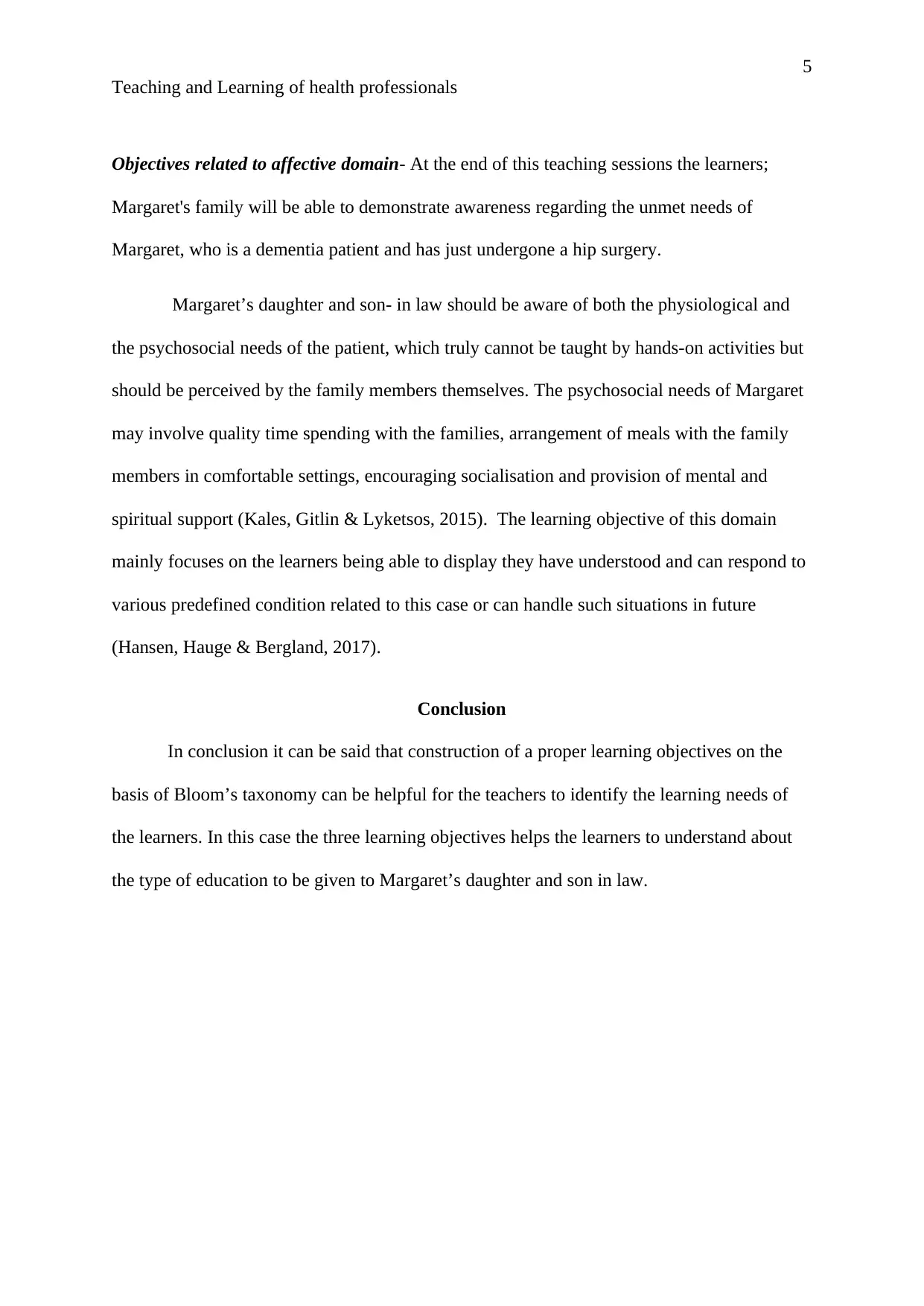
5
Teaching and Learning of health professionals
Objectives related to affective domain- At the end of this teaching sessions the learners;
Margaret's family will be able to demonstrate awareness regarding the unmet needs of
Margaret, who is a dementia patient and has just undergone a hip surgery.
Margaret’s daughter and son- in law should be aware of both the physiological and
the psychosocial needs of the patient, which truly cannot be taught by hands-on activities but
should be perceived by the family members themselves. The psychosocial needs of Margaret
may involve quality time spending with the families, arrangement of meals with the family
members in comfortable settings, encouraging socialisation and provision of mental and
spiritual support (Kales, Gitlin & Lyketsos, 2015). The learning objective of this domain
mainly focuses on the learners being able to display they have understood and can respond to
various predefined condition related to this case or can handle such situations in future
(Hansen, Hauge & Bergland, 2017).
Conclusion
In conclusion it can be said that construction of a proper learning objectives on the
basis of Bloom’s taxonomy can be helpful for the teachers to identify the learning needs of
the learners. In this case the three learning objectives helps the learners to understand about
the type of education to be given to Margaret’s daughter and son in law.
Teaching and Learning of health professionals
Objectives related to affective domain- At the end of this teaching sessions the learners;
Margaret's family will be able to demonstrate awareness regarding the unmet needs of
Margaret, who is a dementia patient and has just undergone a hip surgery.
Margaret’s daughter and son- in law should be aware of both the physiological and
the psychosocial needs of the patient, which truly cannot be taught by hands-on activities but
should be perceived by the family members themselves. The psychosocial needs of Margaret
may involve quality time spending with the families, arrangement of meals with the family
members in comfortable settings, encouraging socialisation and provision of mental and
spiritual support (Kales, Gitlin & Lyketsos, 2015). The learning objective of this domain
mainly focuses on the learners being able to display they have understood and can respond to
various predefined condition related to this case or can handle such situations in future
(Hansen, Hauge & Bergland, 2017).
Conclusion
In conclusion it can be said that construction of a proper learning objectives on the
basis of Bloom’s taxonomy can be helpful for the teachers to identify the learning needs of
the learners. In this case the three learning objectives helps the learners to understand about
the type of education to be given to Margaret’s daughter and son in law.
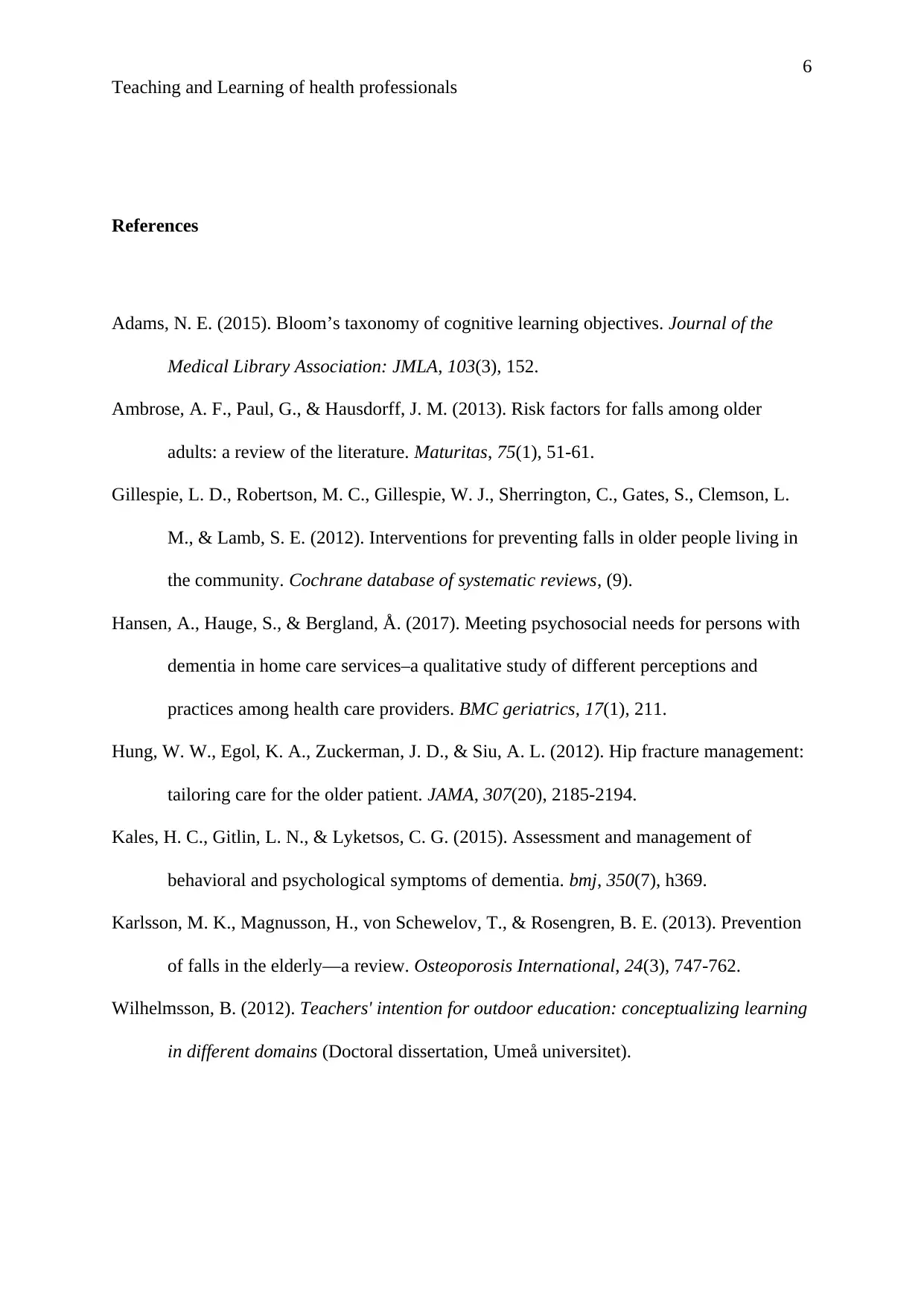
6
Teaching and Learning of health professionals
References
Adams, N. E. (2015). Bloom’s taxonomy of cognitive learning objectives. Journal of the
Medical Library Association: JMLA, 103(3), 152.
Ambrose, A. F., Paul, G., & Hausdorff, J. M. (2013). Risk factors for falls among older
adults: a review of the literature. Maturitas, 75(1), 51-61.
Gillespie, L. D., Robertson, M. C., Gillespie, W. J., Sherrington, C., Gates, S., Clemson, L.
M., & Lamb, S. E. (2012). Interventions for preventing falls in older people living in
the community. Cochrane database of systematic reviews, (9).
Hansen, A., Hauge, S., & Bergland, Å. (2017). Meeting psychosocial needs for persons with
dementia in home care services–a qualitative study of different perceptions and
practices among health care providers. BMC geriatrics, 17(1), 211.
Hung, W. W., Egol, K. A., Zuckerman, J. D., & Siu, A. L. (2012). Hip fracture management:
tailoring care for the older patient. JAMA, 307(20), 2185-2194.
Kales, H. C., Gitlin, L. N., & Lyketsos, C. G. (2015). Assessment and management of
behavioral and psychological symptoms of dementia. bmj, 350(7), h369.
Karlsson, M. K., Magnusson, H., von Schewelov, T., & Rosengren, B. E. (2013). Prevention
of falls in the elderly—a review. Osteoporosis International, 24(3), 747-762.
Wilhelmsson, B. (2012). Teachers' intention for outdoor education: conceptualizing learning
in different domains (Doctoral dissertation, Umeå universitet).
Teaching and Learning of health professionals
References
Adams, N. E. (2015). Bloom’s taxonomy of cognitive learning objectives. Journal of the
Medical Library Association: JMLA, 103(3), 152.
Ambrose, A. F., Paul, G., & Hausdorff, J. M. (2013). Risk factors for falls among older
adults: a review of the literature. Maturitas, 75(1), 51-61.
Gillespie, L. D., Robertson, M. C., Gillespie, W. J., Sherrington, C., Gates, S., Clemson, L.
M., & Lamb, S. E. (2012). Interventions for preventing falls in older people living in
the community. Cochrane database of systematic reviews, (9).
Hansen, A., Hauge, S., & Bergland, Å. (2017). Meeting psychosocial needs for persons with
dementia in home care services–a qualitative study of different perceptions and
practices among health care providers. BMC geriatrics, 17(1), 211.
Hung, W. W., Egol, K. A., Zuckerman, J. D., & Siu, A. L. (2012). Hip fracture management:
tailoring care for the older patient. JAMA, 307(20), 2185-2194.
Kales, H. C., Gitlin, L. N., & Lyketsos, C. G. (2015). Assessment and management of
behavioral and psychological symptoms of dementia. bmj, 350(7), h369.
Karlsson, M. K., Magnusson, H., von Schewelov, T., & Rosengren, B. E. (2013). Prevention
of falls in the elderly—a review. Osteoporosis International, 24(3), 747-762.
Wilhelmsson, B. (2012). Teachers' intention for outdoor education: conceptualizing learning
in different domains (Doctoral dissertation, Umeå universitet).
1 out of 7
Related Documents
Your All-in-One AI-Powered Toolkit for Academic Success.
+13062052269
info@desklib.com
Available 24*7 on WhatsApp / Email
![[object Object]](/_next/static/media/star-bottom.7253800d.svg)
Unlock your academic potential
© 2024 | Zucol Services PVT LTD | All rights reserved.





